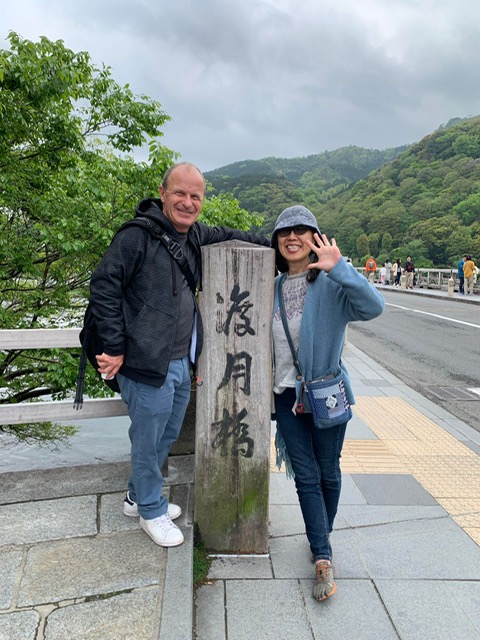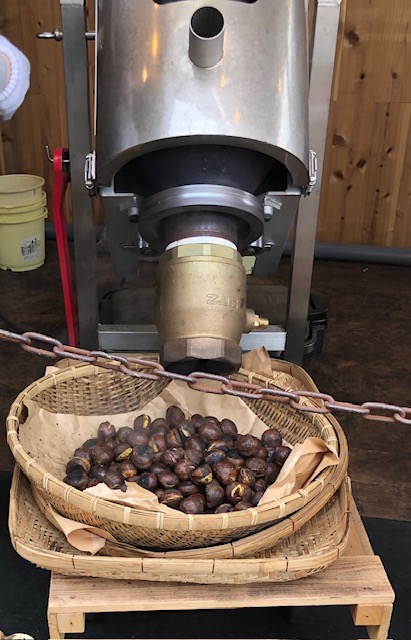It was on my mind to continue writing about the trip to Japan last spring, but once I lost the rhythm of focusing on writing, I could not get back to setting my mind to write.
Early this morning, it was raining.
I was listening to the sound and feeling the moisture of the air.
It was more humid than usual, and I remember living in Japan.
Instead of turning around on my bed, I got up and watched how the rain was coming down.
I felt an emotional atmosphere and followed my feelings.
The sky was milky indigo dark, and the color changed just before dawn to almost dark purple, which I could easily miss.
The sound stopped for a moment before birds sang.
I love this color before dawn and the moment of silence, and I feel I can love myself even though I am not productively living when I notice them.
Finally, I got the motivation to write (took time to sort out the photos – now October, but I hope you enjoy reading and seeing the photos.
So here I am, “Japan Spring 2023 Diary Day 6 Kyoto.”
Kyoto has been a very popular destination for Japanese people and foreigners for a long time as the cultural capital of Japan.
My most memorable visit to Kyoto was on a school trip for my 11-year-old elementary school student. I still remember it vividly because I had to write a diary with photos and illustrations as homework.
Ancient and modern cultures and buildings live perfectly together, making Kyoto attractive.
Kyoto People speak a soft, slow dialect, and their foods taste a little lighter than most Japanese foods, and even colors are pastel. 1600 temples and over 400 Shinto shrines in Kyoto.
It was my seventh time.
I woke up at dawn feeling excited coming to Kyoto once again.
When I looked out from my room at Hotel Granvia Kyoto, the sight of Japan Rail Kyoto Station and the mountain scenery lifted my spirits as if to symbolize that it would be a good day. (Kyoto is located in a valley, so I couldn’t see the sunrise from my hotel room)

That morning, I had agreed to meet Marie-chan for the first time in 8 years, so I met her at the Hotel Granvia Kyoto lobby. Eight years ago, she came all the way from Hiroshima to meet us and spent one night and two days with us. As I was thinking about the fun times I had while waiting, Marie-chan came over with a smile on her face.
She is a comrade who went to Kushi Institute together to study to become a macrobiotic counselor. She invited Eric and Me to teach at her macrobiotic school in Hiroshima.
On this day, She chose for us to visit Tenryuji Temple. (Tenryuji (天龍寺, Tenryūji) It is the most important temple in Kyoto’s Arashiyama district. Tenryuji Temple is one of the Kyoto Gozan temples, which are highly prestigious Zen temples in Kyoto.
The last time we came to Kyoto together, I could not walk much, so we took a taxi all over. I was confident to take a train this time, so we took a train from Kyoto station, where our hotel was. I checked how long and how much to go to Arashiyama from our hotel. By taxi: 15 minutes/cost $30 if there is no traffic, taking a train: 35 minutes/$2.
Taking a train and seeing local people and visitors riding was much more enjoyable and less costly. We also saw Twilight Express Train Mizuki at the station. Eric and I want to take the Twilight Express Train one day so we got so excited. Eric, Marie, and I had fun conversations and laughed a lot.


We arrived at Saga-Arashiyama station, and then we walked to Tenryuji Temple. We needed to figure out which direction to go, but we just followed people and reached the temple. There were many little shops on the way so it was difficult not to be distracted, but we decided to go our destination first.
As soon as we got to the temple, I decided to buy a new Goshuincho (-御朱印帳 is, if you want to translate it, a “book of seals.” Most shrines and temples in Japan have a Goshuin (御朱印), a seal that belongs only to that institution.) at Tenryuji.

When my mother was still alive, she and I often visited temples and shrines to collect Goshuin. After my mother passed away, I couldn’t find where it went, so it was time for me to start anew.
Tenryuji Temple is said to be Japan’s first designated historical site and particular scenic spot, retaining the garden’s appearance created by Muso Kokushi approximately 700 years ago.

The cherry blossoms have already fallen this time, and the peonies and wisteria are fully blooming.




I could imagine enjoying beautiful scenery no matter when you visit, with weeping cherry blossoms in spring, fresh greenery in summer, red leaves in autumn, and snow in winter.
After the garden is the famous bamboo forest path, amidst the crowd, I was deeply moved by the power of the bamboo grove.


We walked a lot and got hungry. Marie already made a reservation for a lunch of Shojin Ryori at Shigetsu, a vegetarian restaurant inside Tenryuji Temple.

Shojin Ryori is a cuisine introduced from China during the Kamakura period (1185~1333), along with the teachings of Zen Buddhism.
Shojin Ryori(traditional Buddhist cooking):
It is a cooking method perfected to enjoy the freedom of mind that comes from the harmony of nature and the spirit of eating, which is part of Zen Buddhism’s training. It is a cooking method that is prepared with carefully selected fresh seasonal ingredients. It is a very healthy cooking method that uses vegetables, wild plants, and seaweed as its main ingredients without using any animal ingredients. It was very delicious, and the light, easy-to-eat dishes typical of Kyoto were the best.
It’s made without meat or fish and focuses on seasonal vegetables and mountain plants. Intense flavors such as garlic and onion are also avoided.) for lunch. It was exquisite dishes and delicious.


After the delicious special lunch, we could not miss Tenryuji’s Cloud Dragon before we left. The giant dragon with a cloud painted was so mysterious on the ceiling of the hall of worship. Apparently, it was painted by Japanese painter Matazo Kayama to commemorate the 650th anniversary of Muso Kokushi, the founder of Tenryuji Temple, and the first thing Eric noticed was that it seemed to be staring at him from any 360-degree angle. When he told me about it, I looked at him, and it seemed like he was staring at me everywhere I went. When I read the instructions, it said that the cloud dragon is called 八方睨みの龍 – “the Dragon staring in all directions” because it can stare at you from any direction. Since the temple did not allow us to take a photo, I thought you could get a feel for the atmosphere with the cloud and dragon towel that Marie-chan bought for me.

After leaving Tenryu-ji Temple, we walked along Arashiyama’s Togetsukyo Bridge. We found many souvenir shops, where I also picked up a Goshuin stamp bookcase with an excellent Kyoto-like design.


We sampled a lot, and Eric ate the soft ice cream made from yuba (tofu skin – non-dairy Yuba frozen soft cream), and Marie-chan and I happily hung out while eating steaming freshly roasted chestnuts with black bean coffee.


People in Kyoto wear more traditional Japanese Kimono clothes. I noticed that many rental Kimono shops are now available with choreography that is not old-fashioned but frilly and cute. Many young people are sightseeing wearing Kimonos made of synthetic, polyester, and acrylic fibers instead of expensive pure silk Kimonos.

When we crossed Togetsukyo Bridge, gals were wearing a cute lace, more modern Kimono, so I took a photo of them with Eric.
The Kimono they wore was more modern, with frills and cute accessories. I thought it was lovely. It’s great to pass on Japan’s ancient culture in this way.

On the way home, I was shopping for souvenirs for my friends and neighbors who take care of our dogs and cats, and Eric found a cute orange polka dot pochette and wanted me to use it.

I thought it was too cute but accepted his kindness and gift.
After Arashiyama, we returned to the hotel and took a break.
We ate delicious Kyoto cuisine for dinner near the hotel and had a great time.




We all got excited about the Kyoto experience we had planned for the next day.
To be continue Kyoto trip…
Love, Sanae❤️

